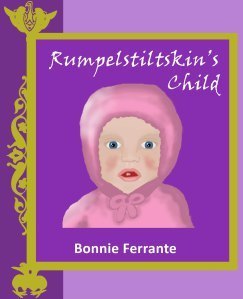Bonnie Ferrante's Blog, page 92
August 23, 2014
Vujijic, Nick. Stand Strong: You Can Overcome Bullying (and Other Stuff That Keeps You Down). Book Review.
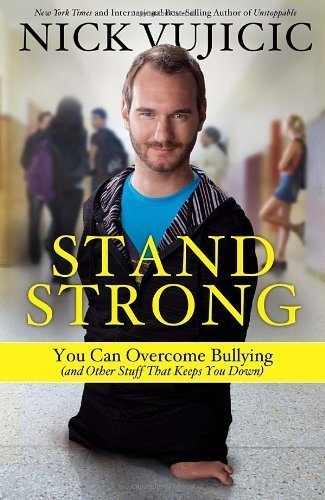
Nick is a man who understands what it’s like to feel helpless in the face of bullies. He was born without arms and legs. He faltered for a while, hanging with a gang of tough kids who did not share his values or interests, in order to feel safe. Eventually he realized he was not being true to himself and developed astep-by-step strategy for dealing with bullies. This enabled him to complete high school and go on to a successful life with the wife, child, and fulfilling career.
At the basis of his strategy is a strong belief in God and faith in the teachings of Jesus Christ. This religious viewpoint increases as the book goes on. Nevertheless, if you are not a Christian, you will still find useful advice.
He explains how to make yourself emotionally strong so as not to internalize the cruel comments of bullies. He discusses support systems and how to build them and the importance of at least one good friend. Cyber bullying is examined and the ways to prevent or deal with it. Nick describes how to keep yourself safe from bullies who might want to physically harm you.
Nick’s positive, life affirming attitude is proof that there are ways to fight becoming a victim. In a time where bullying has gone global through the Internet, young people need help and support more than ever. Whether you are Christian or not, you will find this book a useful tool for discussion or personal reading.


August 22, 2014
Mendenhall, Colin. My Favorite Tree is Dying. Manuscript Response.
I was sent a picture book manuscript written by Colin Mendenhall. I believe this is his first attempt to write in this genre. I have responded with three suggestions for improvement. If you, too, are working on a picture book, you may find these comments helpful.
Colin,
I admire the fact that you are tackling such an important and difficult topic as childhood leukemia in a picture book. Here are my three suggestions for improvement of your manuscript.
First: children’s books should be filled with details of the five senses.
I want the tree to be more real. I think the child would’ve found out what species it was. He should describe the trunk’s texture, the shapes of the branches, or the shape and designs on the leagues. We need to know why he loves it. We can’t feel the loss if we can’t visualize the tree. The same thing with the sick chid. Give us something that makes him memorable other than being bald, something he had before leukemia. It could be a special way of smiling of something else. Even though the book will be illustrated, we need to feel how the narrator connects to the tree and the child. I like the connection between the trees losing its leaves and the boy losing his hair.
Where did they look for a cure? Again, this needs to be vivid. Give us details. Did they look inan anthill? Did they look under a front step? Children this age would not be wandering the neighborhood alone. Maybe they could be searching in each other’s yard or at the park with the parent. Some of this could be shown in the illustrations and not in the text.
Second: the age level is too broad.
You said the target audience was 4 to 8 years old. That’s pretty broad range in interest and reading skills. Children aged 6 to 8 would know that trees lose their leaves. The protagonist in this story seems to be about four or five years old. An eight year old probably won’t read this. The style of writing seems suited to a 4 or 5-year-old but the topic is suited for 6 to 8 years old. You’re going to have to work on merging the two.
I know you’re trying to sound like a child narrating the story but avoid sentences like this. ” I went to ask the boy in my class where he found his cure at.” Parents want beautiful language in their children’s books.
Third: clarify your message
What is the message you’re trying to give children? This is a sad story about a disease that touches the lives of many. Although there are some parallels between the tree and the child with leukemia, the tree does not actually have a cure. It follows the natural cycle. I think this muddies the comparison between the two. You might want to consider giving the tree and actual disease that does get cured.
Are you trying to give children hope that a cure will be found? If so, I would make the last page little more uplifting. Children’s stories should always end on hope.
A question:
On page 20, who is the she standing in front of the hospital? Is it the teacher or the child telling the story?
This book has a lot of potential. Keep working on it and don’t rush into publication. Done well, this could be a very important book for children. Thank you for submitting it and good luck.


August 21, 2014
Which cover do you like best?
I’ve received a truck load of conflicting advice on my new Rumpelstiltskin cover. It is a children’s picture book that has gold (highly embellished) illuminated manuscript style pages for the text.
Which of these do you like best?
Blue boy with flowers.
or
Pink girl on flag.
or
Golden straw.
**The babies could be switched if necessary.


August 20, 2014
King, Stephen Michael. Emily Loves to Bounce. Book Review.
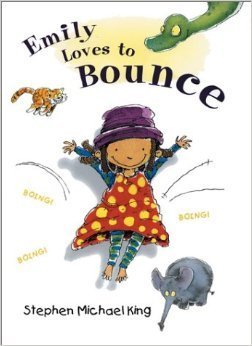
This book is advertised on Amazon.com as suitable for children aged 3 to 6. I would have to disagree. The “story” is much more suited to two or three-year-olds. Basically, Emily loves to bounce. She bounces in many different ways and in many different places until she goes to bed. That’s it.
With safety in mind, some parents might not like the idea that Emily’s favorite place to bounce is on Mum and Dad’s bed.
The illustrations are delightful and full of life. Emily is obviously a happy, imaginative child. At times, the text rhymes. The words lead themselves well to being read aloud, but the rhythm changes.
A preschooler who loves to bounce will probably enjoy this book but it feels lacking something to me.


August 18, 2014
Chodos-Irvine, Margaret. Best Best Friends. Book Review.
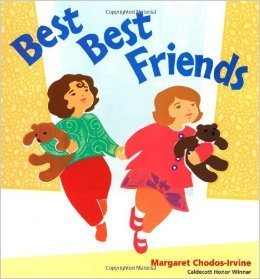
This is a perfect book for preschool and kindergarten children. Clare and Mary are best friends. They do everything together and love each other’s company. But, on Mary’s birthday she gets to be first in line, wear a golden birthday crown, and have a special cupcake. In a jealous moment, Clare is unkind to Mary and a fight ensues. The girls go their separate ways. After a while, Clare draws a birthday card for Mary and their friendship is repaired. When their parents come to take them home, the girls wave to each other and call, “See you tomorrow!”
The storyline is simple and relevant to children who attend day care or kindergarten and are venturing into a social world beyond their family. Each page has only a few words and the pictures are easy to understand.
Every child has squabbles with her best friend. This book will enable parents to discuss jealousy and hurtful remarks with their young child. It is important for children to understand that fights don’t have to be forever and there are ways you can repair a relationship.
The pictures are bright and simple collages with detailed patterns stamped on items of clothing with paint. With the simplest of lines and shapes, Chodos-Irvine portrays the girls’ happiness, anger, resentment, and acceptance.
It is easy to see why this charming little book is a Caldecott Honor Winner. Highly recommended.


August 16, 2014
Reinoehl, Jason and Jennifer Reinoehl. The Corruption: Age of the Watchers (The Lost Histories of Eden, #1). A YA Book Review.

I was given an e-book copy of this fantasy in exchange for a fair review. It took a long time for me to read as I had to keep forcing myself back to it. This is unfortunate, because the writers spent enormous effort planning the back story for this series. I would recommend that future books be given to an editor for feedback on pacing, plotting, and characterization before publishing.
The Corruption started with a detailed, expansive and largely unnecessary prologue told in the first person by a chatty narrator. Once into the story, this completely disappeared. Basically the plot is this. Wicked angels come to earth and try to rule the humans. They bribe them with the gift of knowledge and take human women as sexual toys and breeders. Not all cities agree to be part of this coalition. I loved the premise. I really wanted to get into the heads of the main characters and feel their turmoil and fear.
However, the dialogue is stiff, wordy, artificial, and, at times, even pompous. Everyone speaks the same way. There is an overuse of descriptive dialogue tags. 90% should be substituted with the word said. Slowing down the text even further, adverbs and extraneous explanation often accompany the excessive dialogue tags. For example: “Don’t worry, I will,” Asbel smugly concluded. “Jeqon, what a surprise to see you here,” the man spoke in a kind voice that was forceful enough to be demanding.
Characters often sound like they feel compelled to use five words when one will do: “As to this debate, my mind is already decided. Now, excuse me as I entertain myself while you finish with your insignificant pretensions. I should be ready to discuss the more important details when you finish. And if Michael does appear before you conclude, I shall be satisfied that I have spent my time enjoying myself instead of trying to be more pious than the rest of you.” The spheres took orbit over his knee and he locked glared with Arataqoph. (error in text – quite a few in fact.) The characters had potential but with similar dialogue and a distant, report-like style of writing, the reader has difficulty connecting or caring about any of them.
The text drags because the authors often use passive writing. For example, in the above paragraph it could have read: the spheres orbited over his knee. Unnecessary detail that does nothing to further the plot also weighs down the novel. For example: Once the light of one door met with the light of the other, the doors began to open slowly and majestically. Jeqon waited until the door stood completely open before entering into Shemihazah’s chambers.
The rebellious angels’ flights down from heaven was interesting. The plot, unfortunately, seems to jump here and there and it was often difficult to know who was supposed to be the reader’s focus. The plot read like a videogame with huge chunks of emotionless battles. It seemed that every chapter introduced a new creature of terror.
The end was plausible, if sudden, but then the authors tagged on a bewildering little cliffhanger to get the reader to buy the next book. I cannot, in all honesty, recommend this.


August 15, 2014
Hines, Anna Frossnickle. Rumble Thumble Boom. Book Review.
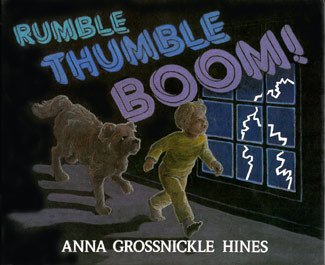
This is the story of a little boy and his dog Hercules who fear thunderstorms. No matter what his family tells him, the child is still afraid of the noise. When hiding under the bed doesn’t help, Hercules and the boy go to Daddy and Mommy. The boy climbs into bed but Mommy draws the line at having the dog in her clean sheets. The boy doesn’t want to abandon the dog. He convinces his parents to sleep with him on the old sofa bed with the old sheets. At the end he feels safe and secure tucked in between Daddy and Mommy.
Although the child is unable to accept the various explanations, some mystical and some scientific, of what makes thunder, no one in his family embarrasses, scolds, or belittles him. He is met with love and support. This would be a great book to read to a child who is afraid of storms or other natural events. (But be prepared to have the child in your bed.) It would stimulate a great discussion on fears, acceptance, and different viewpoints. The boy says “Herc and Daddy and Mommy and I all snuggled in. Now that feels cozy. Daddy groans. Mommy shivers.”
The illustrations are wonderful. The pages are black with white text. Large, three-dimensional, sound words in various colors show us how loud the thunder sounds. Pictures of the boy, his dog, and his parents are beautifully realistic without being cluttered. They seem to be done in pastels which give the scenes a muted night time feel.
A lovely family story.


August 13, 2014
Mack, Todd. Princess Penelope Takes Charge. Illustrated by Julia Gran. Book Review.
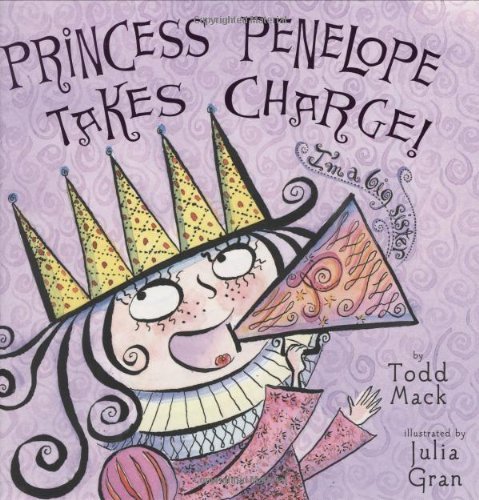
Penelope has everything a child could ever want, except for baby sister. She’s delighted when she learns that her mother is pregnant. She fantasizes all the wonderful things she will do with her baby sister but, to her dismay, Mommy comes home with a little boy, Dexter. Her mother says he will be fun to play with but Penelope is repeatedly disappointed. The baby mostly sleeps and watches. Eventually, Penelope begins to help to care for her little brother and engages him in play. She reads to him and sings to him and finally realizes, “she has absolutely everything.”
This would be a perfect book to read to a child who is expecting his or her first sibling. It will help parents discuss what babies can do and how engaging with them requires patience and time. If the gender of the baby is unknown, it is important for the child to understand that the gender of the baby is unpredictable.
Julia Gran’s illustrations are simple cartoons that gives the story a sense of fun. The title was a poor choice and should have had a better connections to the story.
Well recommended.


August 11, 2014
Macomber, Debbie and Mary Lou Carney. The Truly Terribly Horrible Sweater… That Grandma Knit. Illustrated by Vincent Nguyen. Book Review.
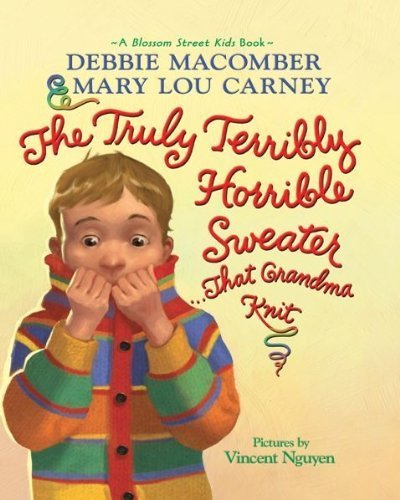
Cameron is very excited to receive a birthday gift from his grandmother. She always gives him the best gifts, but this time he is deeply disappointed. Inside the box is a handknit sweater striped with green, blue, orange, and yellow. Cameron is mortified and vows to never ever wear it, especially in front of his friends. He tries a series of tricks to get rid of the sweater, but doesn’t succeed.
His mother says, “Grandma Susan would have been heartbroken if anything happened to this sweater.” Finally, Cameron begins to think about his grandmother’s feelings, but not enough to wearthe sweater. When grandma comes to visit, Cameron’s mother insists that he put on the sweater.
Grandma explains the significance of each color. Green represents Cameron’s excellent soccer skills, blue represents his success at learning to ride a two wheeled bike, orange represents his favorite fruit, yellow represents how happy his birth made the family, and red represents how he is always in his grandmother’s heart. Cameron’s attitude toward the sweater changes. He vows to wear it for a very long time.
Every child has received a gift that was disappointing. This book will remind them that the thought behind the gift is more important than the present itself. It also stresses the special link between grandmothers and their grandchildren and how different generations show their love in different ways. The story will encourage living life with a sense of gratitude, one of the most important keys to happiness.
Vincent Nguyen uses branch double spread pictures to illustrate the story. That this is a happy, loving family is apparent from the expressions of the characters.
Highly recommended.


August 6, 2014
Hundal, Nancy. Camping. Illustrated by Brian Deines. Book Report.
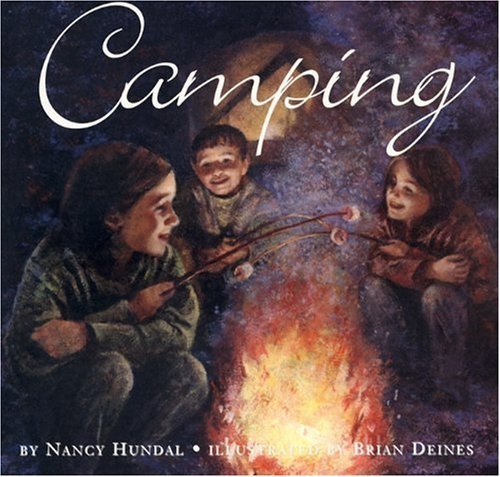
Everyone in the family has their own idea of the perfect vacation, museums and art galleries, fancy hotels, malls, arcades, and Disneyland. But, due to a lack of money, the family goes camping. Bit by bit the simple wonders of campfires, swimming in the lake, evening stars, cold drinking water, and doing absolutely nothing win over the family.
Nancy Hundal’s writing is beautifully poetic, “We feel the sun’s journey across our campsite. It taps her tent in the morning, pours like syrup warm and sick at noon. By evening, gentle fingertips of light massage the trees good night.” She gets across the silence and restfulness of the forest and the family’s connection to its simple, gentle beauty.
Brian Deines uses one and a third to full double page spreads for his illustrations. They look like oil paintings, some striking enough to belong in an art gallery. They capture the sense of gratitude and wonder perfectly.
This is a perfect picture book for anyone who’s ever said, “Why would you ever want to go camping?”
Highly recommended.






